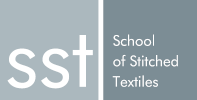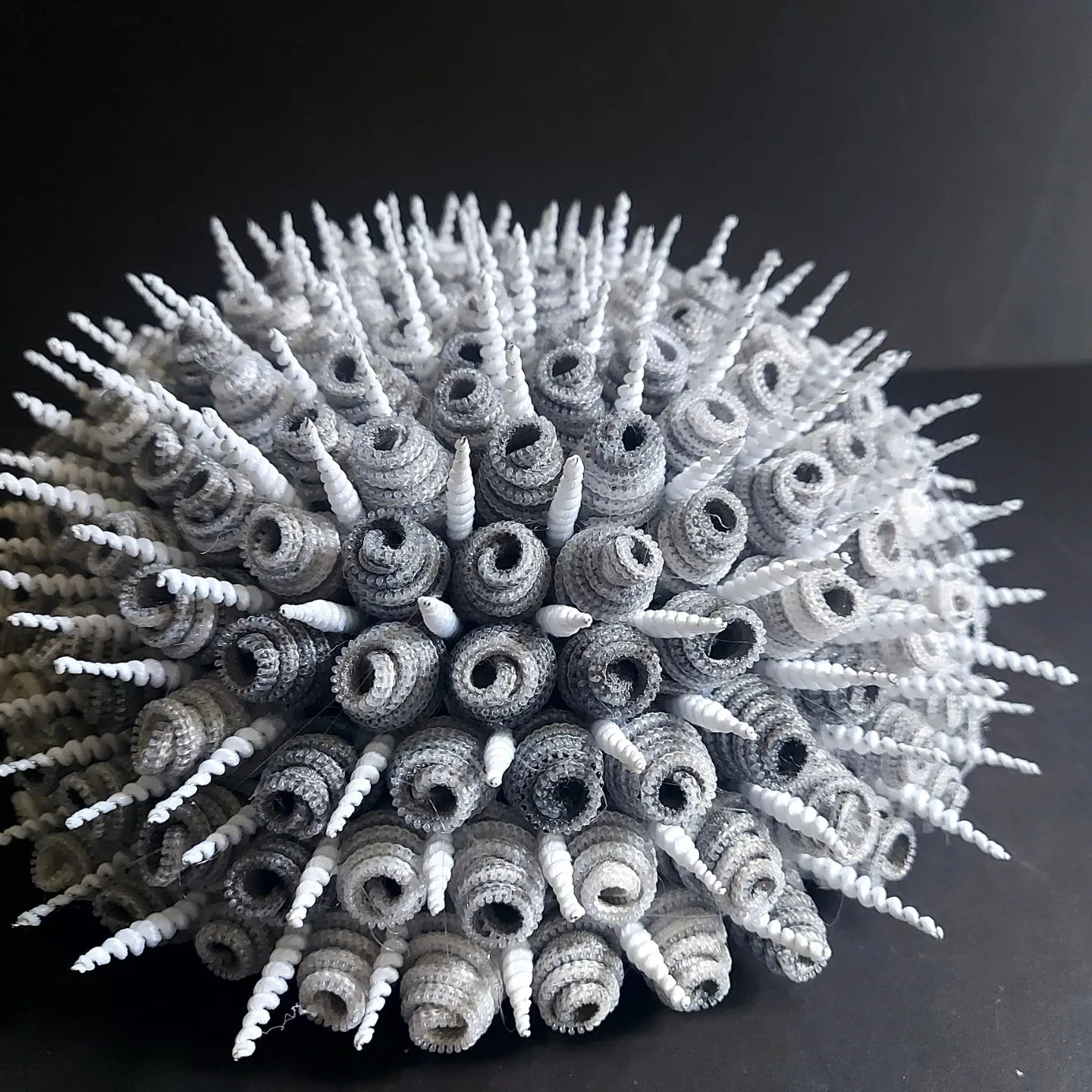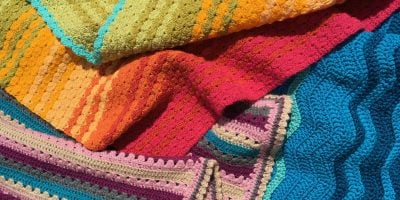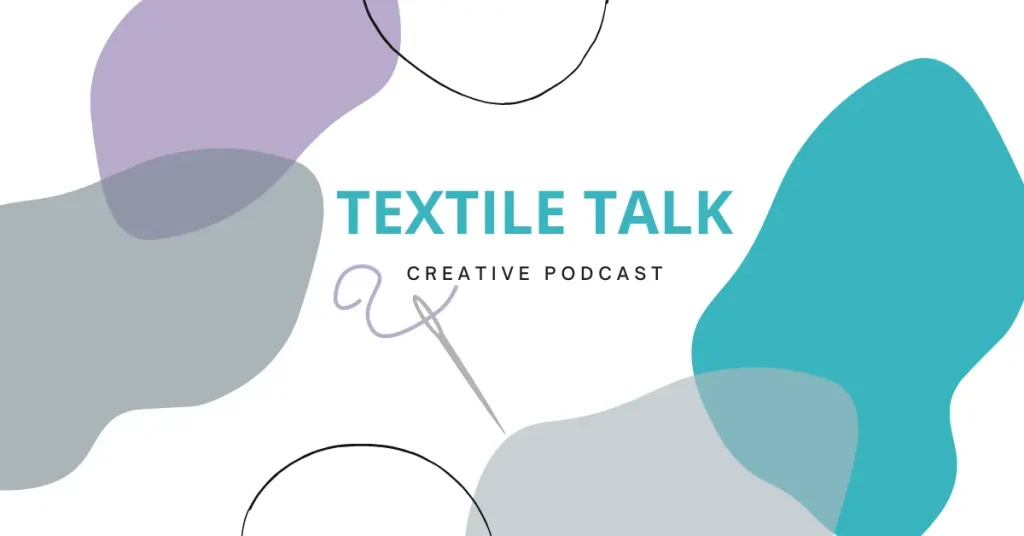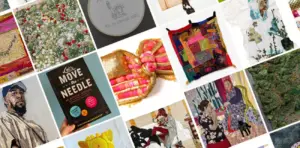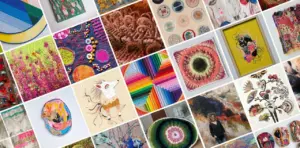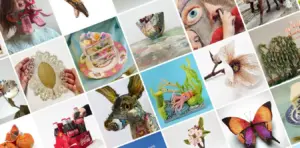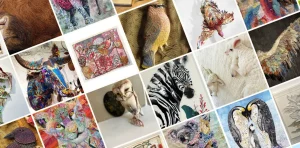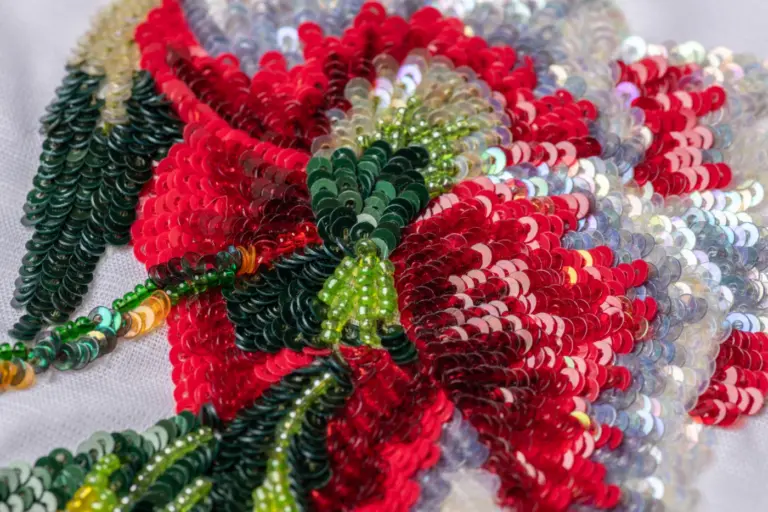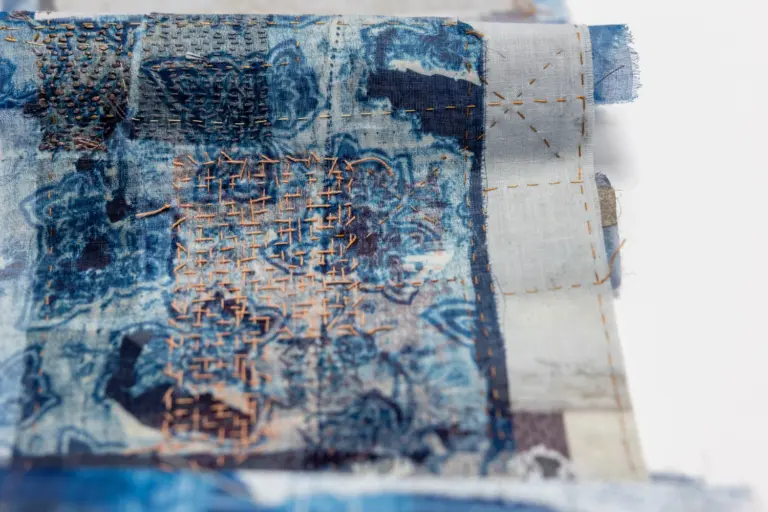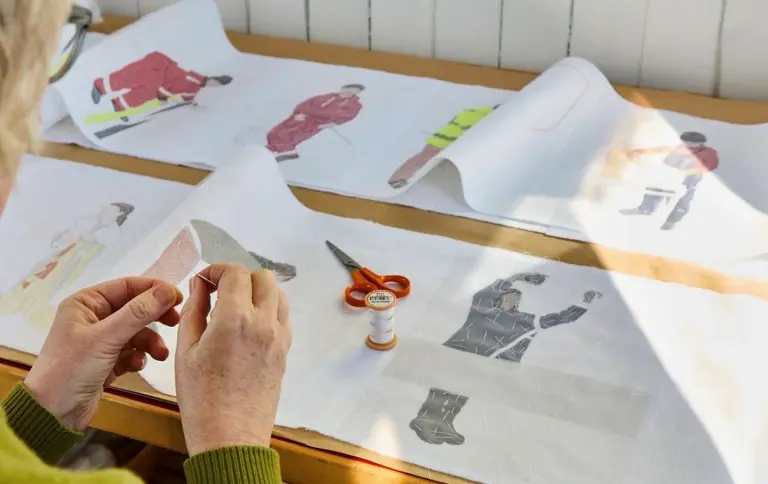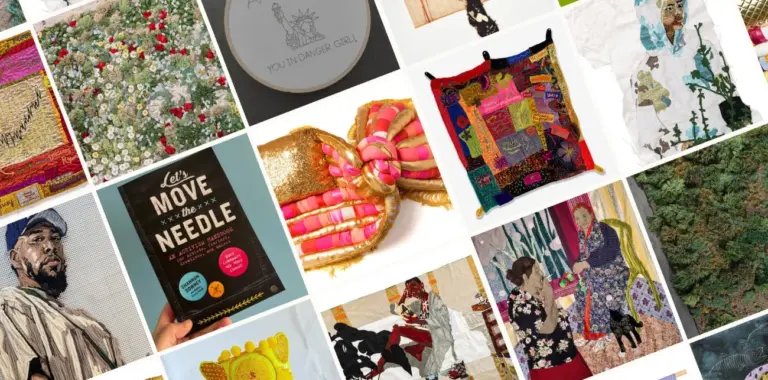We recently explored 10 Textile Sculptors that bring life to art, and like them Marian Jazmik is no exception. With a distinctive style that fuses the organic with the experimental, textile artist Marian Jazmik has carved out a remarkable career. With a life-long passion for surface, structure, and the tactile beauty of nature, she is a true innovator in the field of contemporary textiles. Marian’s work is renowned for its highly textured, three-dimensional forms that blur the boundaries between sculpture and stitch.
Though her professional journey began in the classroom, Marian’s creative spark ignited when she took over a textiles post and decided to rewrite the rulebook. Her commitment to revitalising the curriculum led her to study Creative Embroidery with City & Guilds, which laid the foundation for the bold, process-driven work she produces today. After retiring in 2013, she finally found the time and space to fully explore her own creative voice, and the results have been nothing short of breath taking.
Marian’s work is deeply rooted in her relationship with nature. Not just in its outward beauty, but in its overlooked textures: the bark of a tree, the wrinkled surface of lichen, the erosion of rocks by wind and tide. Her style is instantly recognisable. Monochrome or pastel in palette, yet never minimal. These are pieces that demand closer inspection. Her vessels, wall art and abstract spheres often appear fossilised or unearthed, as if extracted from the natural world rather than made by hand. There’s a remarkable synergy between fragility and strength, intricacy and boldness—a tension that reflects the natural elements that inspire her.
In this interview Marian shares the stories behind her practice, offers insights into her unique techniques, and reveals what’s next on her creative horizon.
Marian Jazmik
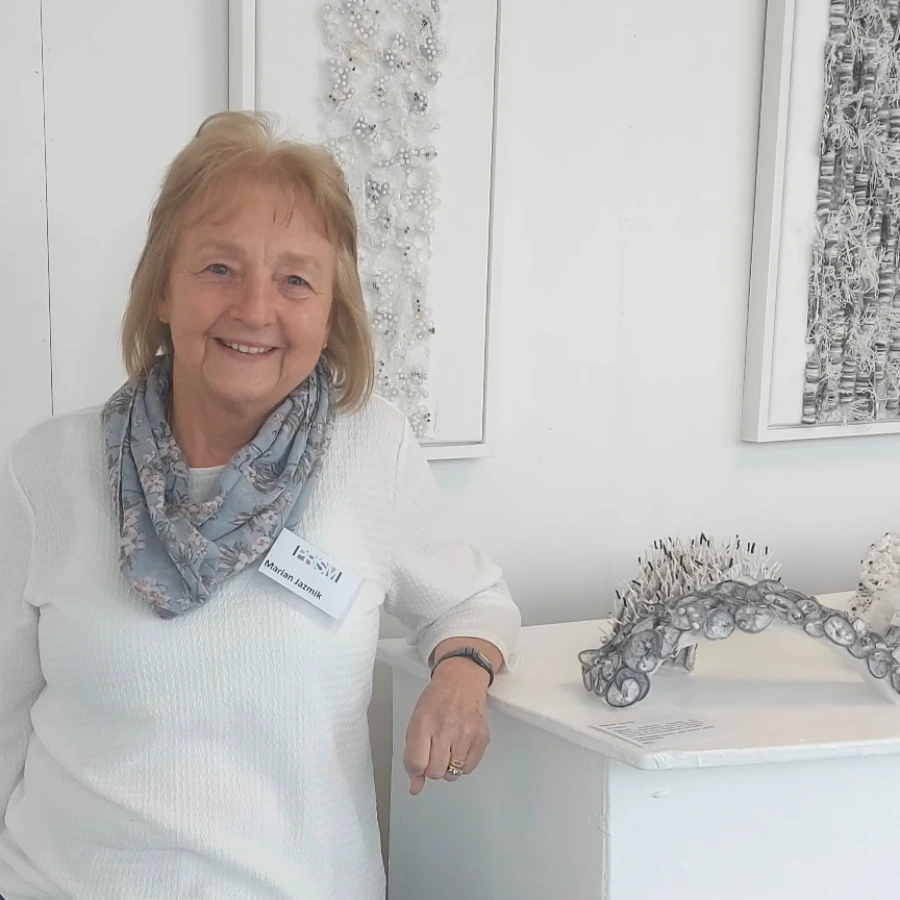
“I don’t always know down which road my work is leading me, but I am happy to be led by my experimentation in order to develop a design.”
Tell us about your textile journey
I was originally trained as a Home Economics teacher specialising in food technology. I taught at the local comprehensive school for over 30 years and it was during my early career that I was asked to cover the maternity leave of the textile teacher. I had always done some simple dressmaking at home and so I embarked on carrying out the tradition of teaching the obligatory apron, skirt, blouse and nighty! The textile teacher decided to leave teaching and I was offered her post.
I soon realised that the curriculum needed a shake up! So I embarked on a part time City and Guilds Creative embroidery and Design course and changed the subject to ‘Creative Textiles’. Introducing creative textiles really inspired the pupils and I was soon enrolled into the Art department as well as becoming Head of Design Technology. During this time I became a member of a post City and Guilds group exhibiting in the North West England.
Sadly, the demands of teaching and raising a family meant there was little time left to create and develop my own work to any degree. However, following retirement in 2013 I set up a workroom at home and my creative journey began in earnest.
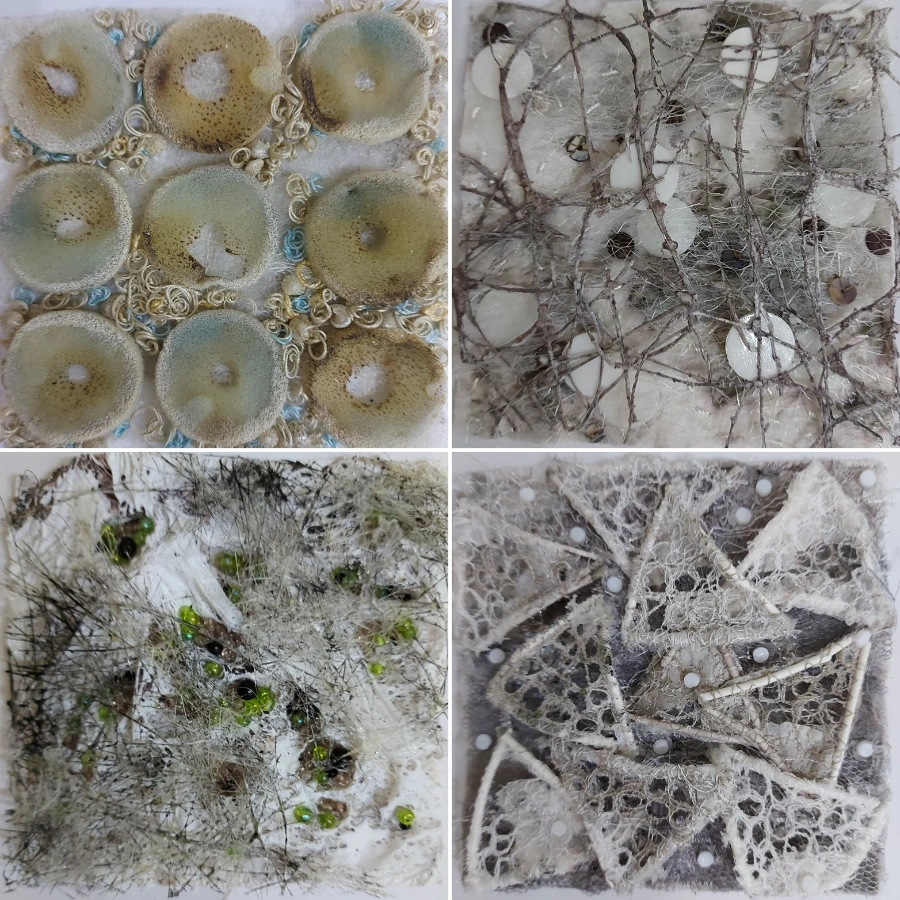
You’ve said you love to photograph nature. How do you turn these into a workable design?
I am inspired by nature, by the unseen, by the overlooked and ultimately by the hidden textures observed on a variety of surfaces found in the countryside, the urban environment or the coast. In fact my camera phone is always with me to capture any surfaces that I find interesting wherever I go. For me it really is a case of not only looking but also seeing what is around.
When I first starting taking images I would use a standard camera which I would take with me whenever I went for a walk, I would download the images onto the computer and enlarge the image to reveal what is not always visible to the naked eye. It was always a somewhat surprising reveal. However, I now have a camera phone with a macro image facility and so I use this to capture images and simply save them to the computer. I now have thousands!
Using the images to create a workable design involves experimentation. This is a major part of my process. Having captured an image that I find interesting I produce numerous samples by ‘playing’ and by ‘giving it a go’ or by continually asking the ‘what if?’ question. This gives me freedom to simply enjoy creating. No pressure to replicate a pre-planned design but just the pleasure of stitching. It is from these samples that my work develops and leads to my abstract highly textures pieces of wall art, sculptures and vessels.
I create abstract texture pieces of work, they are not a true replication of the images but my own creative interpretation of what I see.
I don’t follow recognised rules.
I don’t sketch.
I don’t plan.
I don’t always know down which road my work is leading me, but I am happy to be led by my experimentation in order to develop a design. It could be said my samples are my library and my sketchbook.
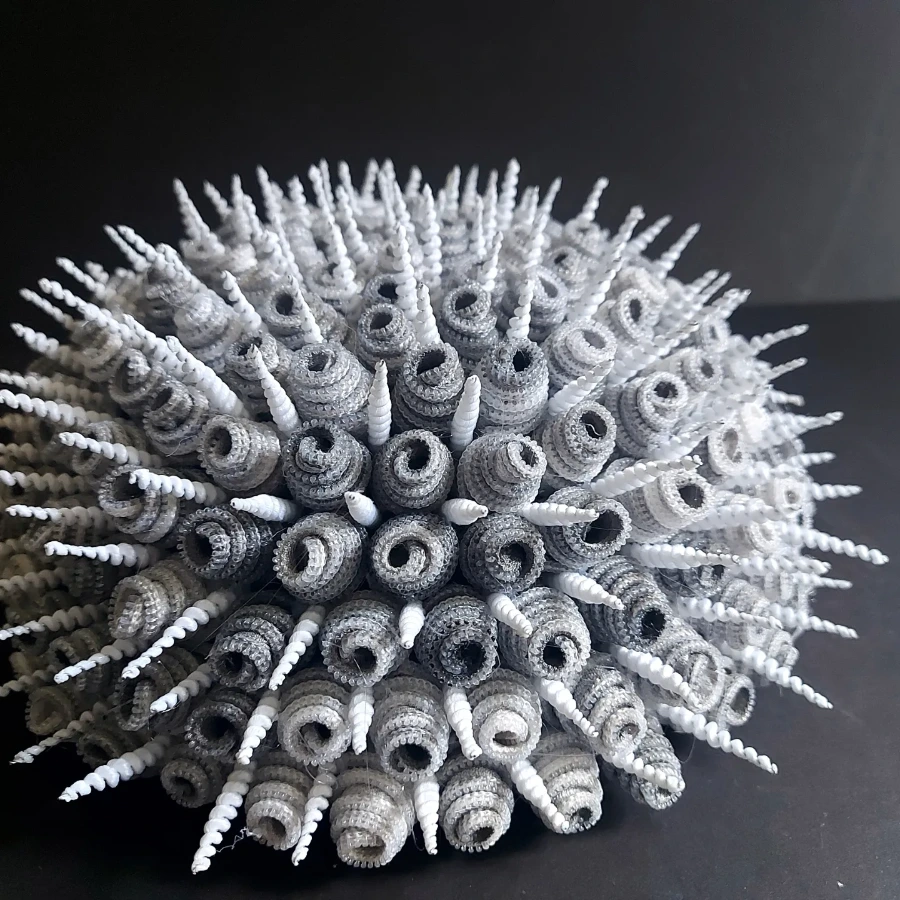
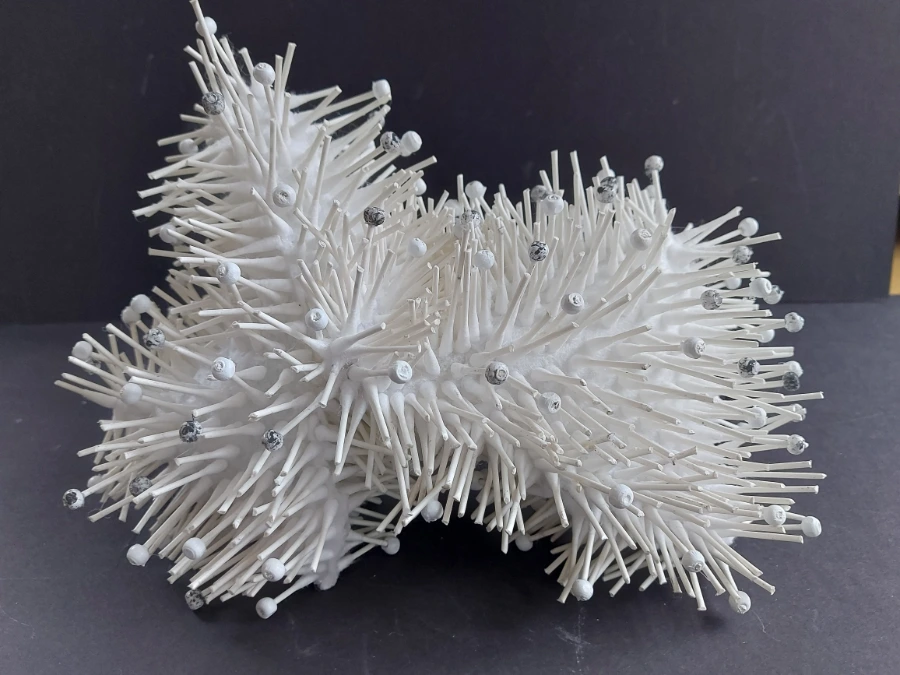
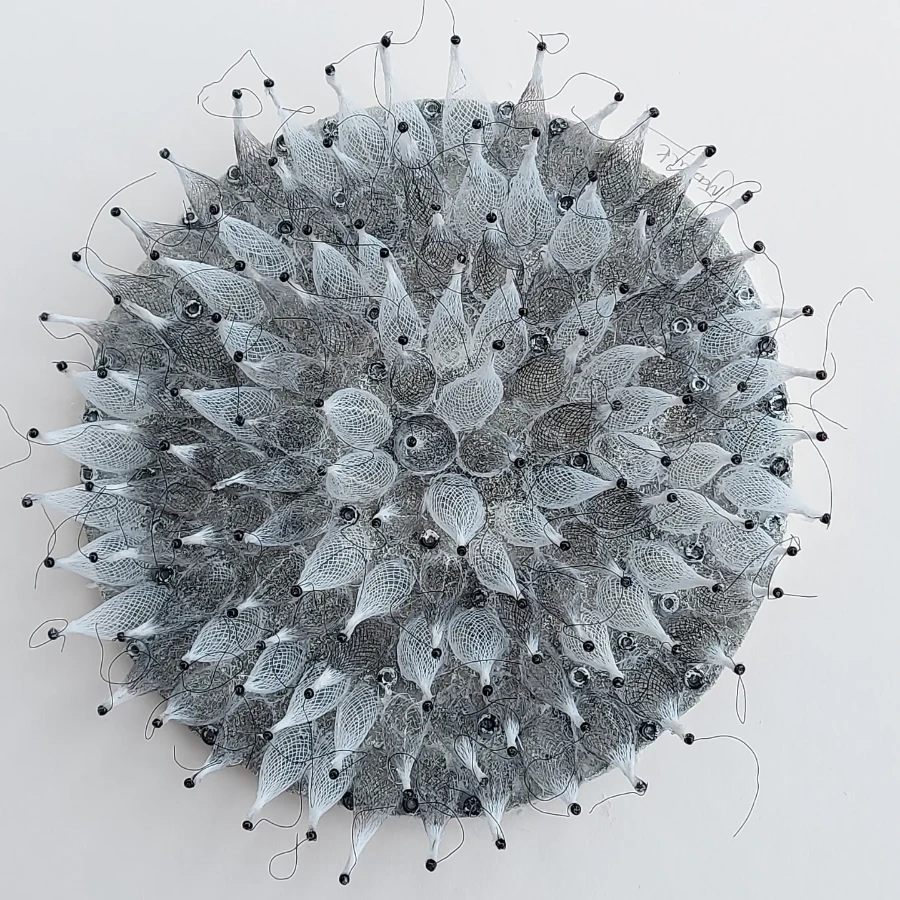
Can you give us some insights into the materials, techniques and processes used to create your sculptural pieces?
I don’t have a drawing or a plan so creating a final piece always develops from my experimental pieces. My driving force is the interpretation and creation of texture.
I usually start by producing a background fabric. This involves the free machining of 4/5 lightweight fabrics (mainly synthetics), which sometimes I will dye although my work is generally monochrome or pastel coloured. Having stitched the fabrics together usually using free machine embroidery I will experiment with various heat treatments and the results will often drive me forward to look at producing the next ’layer’ for further development.
Making 3D sculptures often involves a lot of problem solving and can be quite demanding. I am actually driven by the challenge of finding a solution, I’m sure this harks back to my Design Technology teaching and method of working.
It could be I use papier-mâché as a form to hold the work, maybe I will use attached and incorporated wires to support the structure, sometimes the act of heat treatment sufficiently stiffened the structure so it will hold its shape. Lots of enjoyable trial and error!
Moving on from the form and the background fabric leads to yet more experimenting. In order to create my abstract textures I use not only fibres and fabrics which I construct, deconstruct and manipulate but also many mixed materials often found in the home or acquired via ‘Scrap’ stores selling manufacturers surplus materials and off cuts which otherwise would go to land fill.
Some of my favourite materials include flower head protectors, sponges, hair accessories (bobbles, bun fabric, and nylon tubing), electrical materials (washers, wires) and a wide variety of packaging and gardening materials.
I enjoy pushing the boundaries of textiles as an art form.
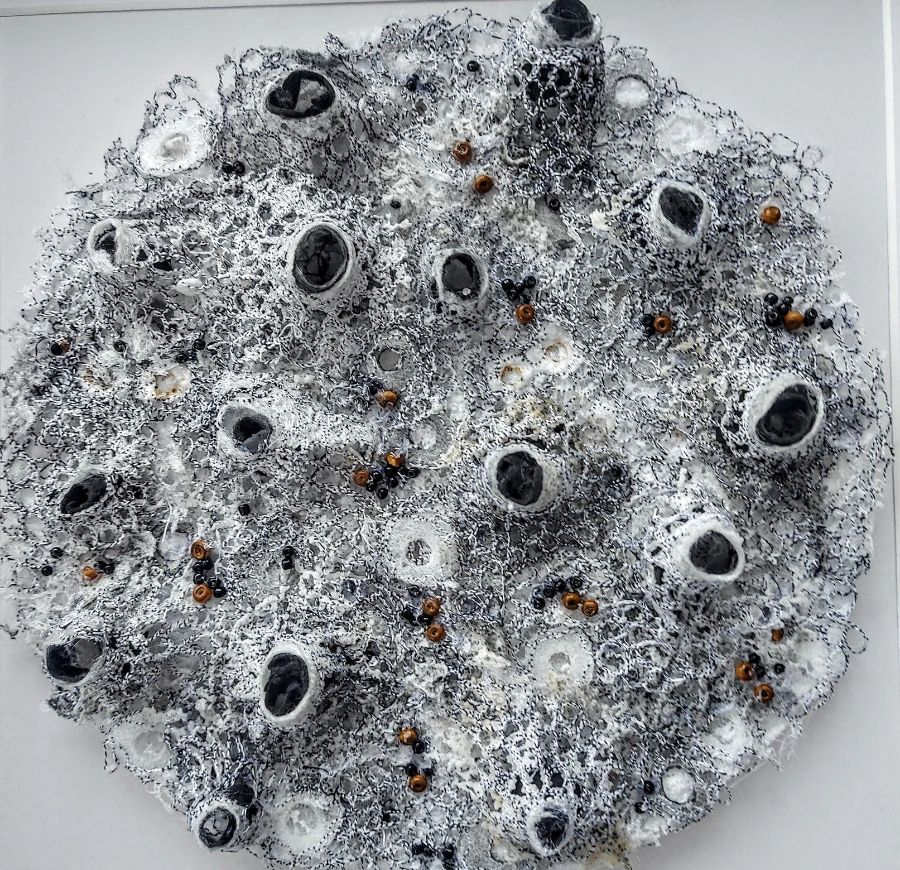
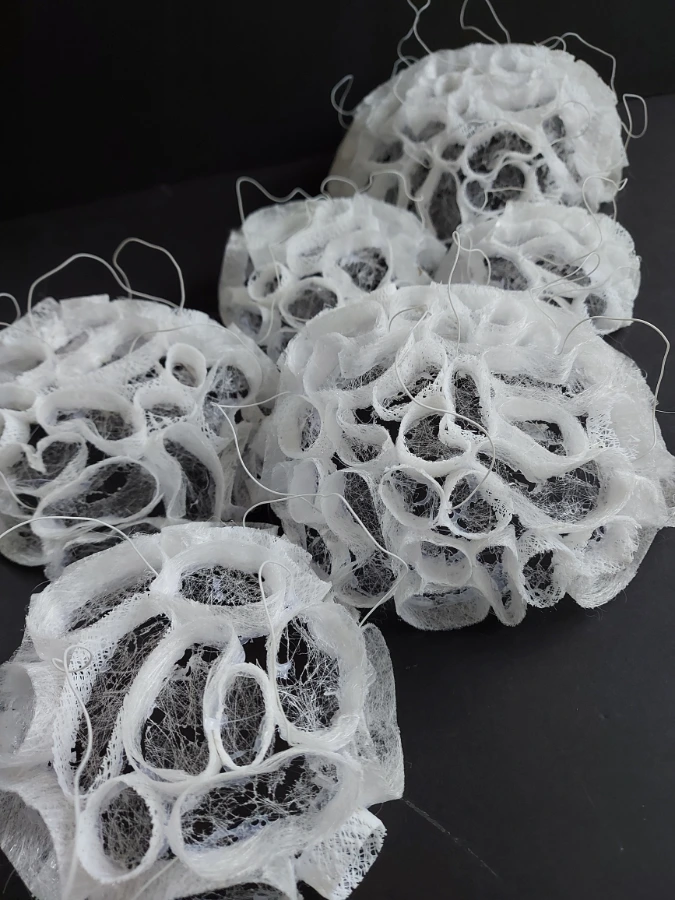
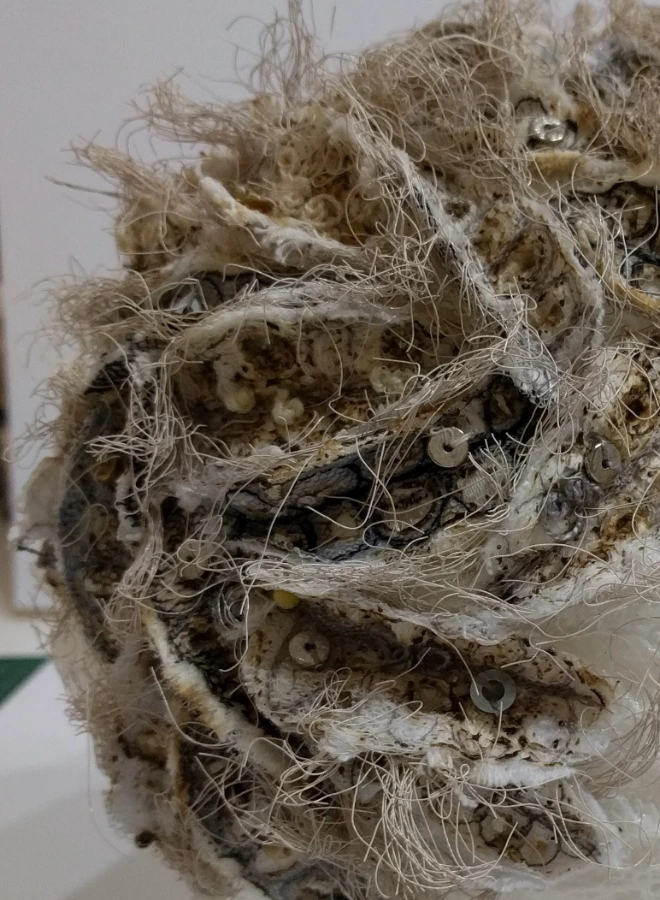
You freely mix hand and machine embroidery and use lots of unusual processes such as soldering irons and heat guns. How would people go about experimenting with these techniques?
I love to change the surface texture of the materials, to do this I use various heat treatments. This is perhaps a little unusual but I am always intrigued by the results.
* HEALTH AND SAFETY – Always wear a full respiratory mask when carrying out any heat treatment.
I use the soldering iron to create holes and to ‘burn’ away layers of fabric. I use the hot air gun to manipulate fabrics and to alter the surface texture. Sometimes I use the naked flame to actual burn away sections of layered fabrics. By using all of these methods I have a vast wealth of ‘what if’ questions to answer.
If you have never tried any of these techniques then simply give it a go. Try organza and the heat gun, watch how the colour intensifies and the fabric wrinkles and changes shape. Try making a multi layered stitched fabric and use the soldering iron to burn sections away or to create holes in other sections.
It is really only trying it out that you will identify a technique you think you may be able to use in your own work.
Some examples –
- Naked flame – several fabrics have been stitched together and held about 5cms away from a flame. In the sphere shown here the shapes were later embellished and the soldering iron was used to create holes.
- Soldering iron – used to create small holes
Layered and heat treated fabrics using hot air gun to produce texture.
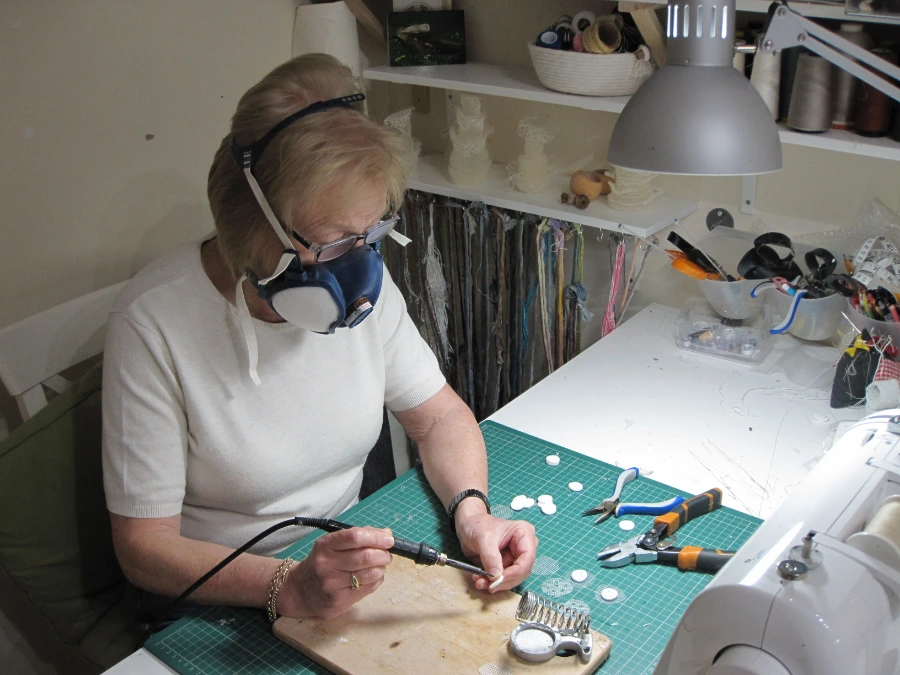
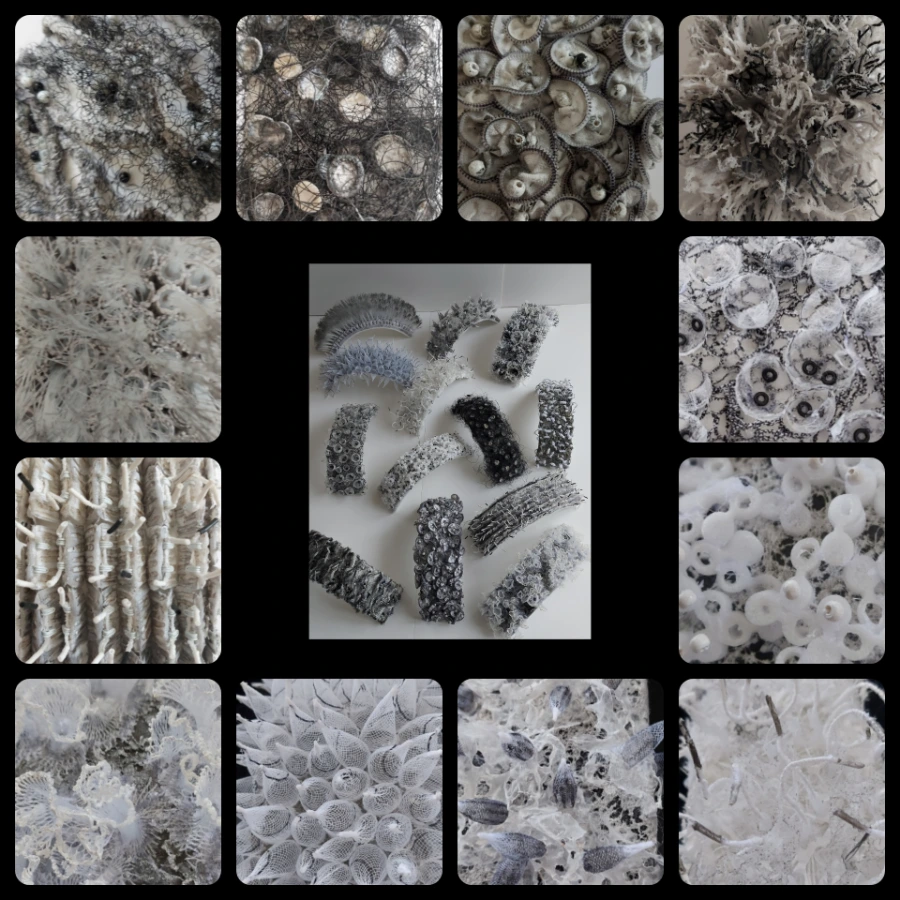
Do you ever suffer from creative block? How to you ignite creative inspiration?
Luckily, I haven’t really struggled with creative block. On finishing a piece or a series often I will go for a walk or I will look through my images or I will visit the scrap store. I don’t push myself to start another piece or series, I just play and enjoy the freedom of experimenting with no pressure to produce.
The only target I work to are those of exhibition submissions and given that my process simply evolves I can be inspired by either the images or by any new fabrics or mixed materials that I may acquire. Experimentation usually allows for the development of an idea as a result of this trialling.
I have recently begun creating pieces as a series, the challenge being to use different processes and techniques to create a variety of pieces based on a single theme such as tree bark, cacti, coral, fungi and lichen.
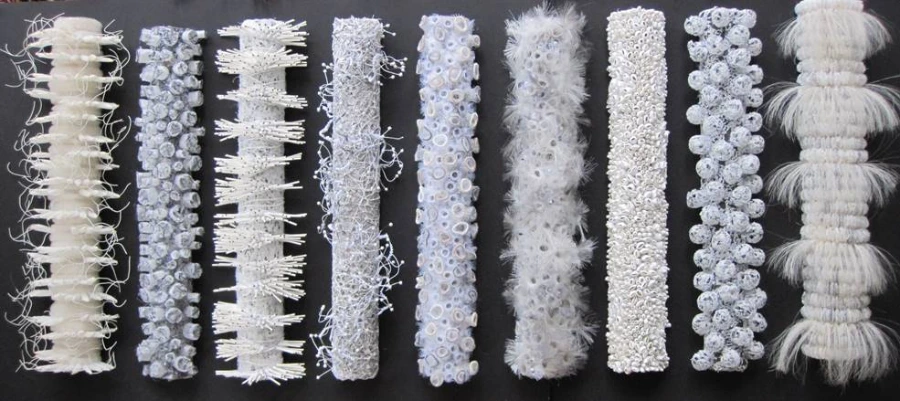
What has been the highlight of your career so far?
It has now been over 10 years since I retired and started to produce my own work. During this time I have been extremely fortunate to be able to exhibit my work, mainly with the Prism International textile group and with the Society of Designer Craftsmen. However, my most rewarding exhibition was my solo exhibition at the Knitting and Stitching shows in 2019, although I was delighted to be shortlisted and exhibited for the Fine Art Textile Award in 2022.
My work is in the Diana Springall collection.
I have been lucky to have articles in many textile art magazines but recently I featured in ‘Embroidery’ magazine and this fulfilled a life time ambition. The biggest highlight of my career so far has to be the publication of my book ‘Textures from Nature in Textile Art’ published by Batsford in 2021.
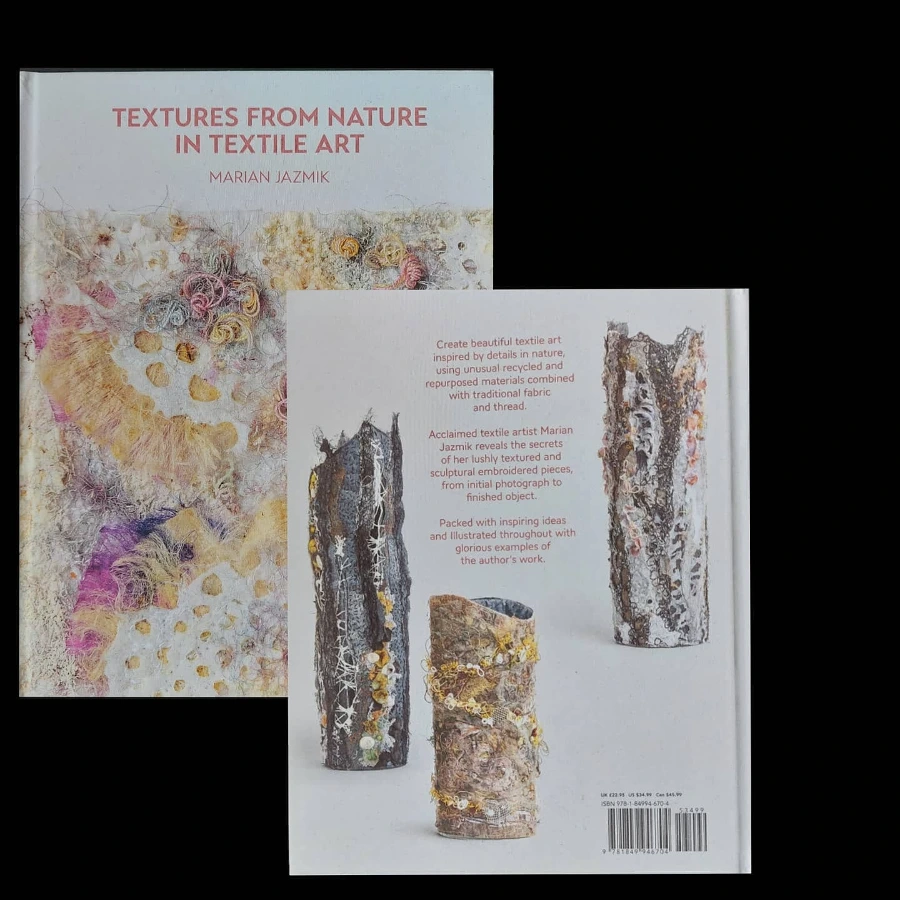
What can we expect next?
At the moment I am working on a couple of series for the next Prism exhibition in April 2025.The latest title is ‘Any Other Business’ and I am creating a series of small spheres inspired by the humble ‘full stop’ and a series ‘Tidal Debris’ to encourage recycling, reuse and remaking.
I am delighted that I will be exhibiting at the Knitting and Stitching show in 2025. A busy year ahead!
Discover more. Follow Marian Jazmik on Instagram.,
